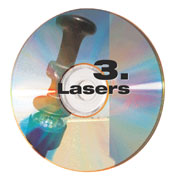 |
Originally an acronym for Light Amplification by Stimulated Emission of Radiation, lasers were first conceived by Albert Einstein, who theorized in 1916 that light could pass through a substance to create more light. Following research in later decades, lasers were made possible by Arthur L. Schawlow and Charles H. Townes of Bell Telephone Laboratories in 1960. They were able to bring visible light to Einsteins idea by expanding earlier studies into what were called "masers," a similar concept to lasers but limited to invisible microwaves.
| RELATED LINKS |
| 10 Electronic Technologies That Changed Construction |
|
1. The Internet Collaboration Is Evolving From Sharing to Managing |
| 2. Computer Aided Design CAD Pioneers Gave Desktop PCs A Full Range of Electronic Drafting |
|
3. Lasers Lasers Have Become Common Element in Industrys Toolbox |
|
4. Analysis Software Speed and Power of Computation Opens Doors to New Possibilities |
|
5. Personal Computers Personal Computers Empowered Users and Launched a New Age |
|
6. The Fax Speeding the Pace of Business and Shrinking the Globe |
|
7. Critical Path Method Network Logic Was Aided By Mainframe Power |
|
8. Calculators Calculators Built on Microchips Doomed Slide Rules |
|
9. Mobile Communications Contractors Were Early Adopters of Mobile Comms |
|
10. Global Positioning Systems Location-Based Technologies Track Construction Operations |
|
What's Next? Innovations Are Ready for Trial and Adoption, But Great Gains Will Take Major Change |
From that point on, a multibillion-dollar technology industry exploded, with applications in any field that needed to draw a straight line fast and with pinpoint accuracy. Interest in construction grew out of early adoption among farmers for earthwork. Beyond widespread construction use, lasers have found a welcome home in todays operating rooms, auto-body alignment shops, retail checkout lines, office conference rooms, security systems and home stereos, just to name a few.
What began as a layout tool for site survey and preparation in the open air has moved indoors. "We have taken lasers through the entire construction process, from start to finish," says Lawrence Smith, segment manager of construction instruments for Trimble Navigation, Sunnyvale, Calif. Like other electronic technologies, lasers will continue to get smaller, more portable and operate under lower power as time goes on, he says.
"Every job has some sort of laser on it now," from rotating laser levels to total stations, says Don Zirbel, technical engineer for James McHugh Construction Co., Chicago. Lasers also help equipment operators improve productivity on motor graders, dozers and excavators, and even allow them to work at night.
One significant tool development was the Laserplane, invented by Robert Studebaker in 1965. His unique design combined early lasers with spinning prisms that gave engineers an electronically produced reference point to accompany optical transits. Studebakers enterprise ultimately became Spectra Precision group, which Trimble purchased in 2000 to complement its line of global positioning equipment, software and technical support services.
In the beginning, laser technology was not for everyone. Some tools could cost at least $10,000 to buy. Big changes in cheaper battery power and servo control came later, but it still took another 20 years for price breaks to fall roughly 50% of 1960s numbers, and yet 10 more years for another 50% drop.
 |
| QUICK CHECK Rotating laser technology has come down in price dramatically since the 1960s. (Photo courtesy of Trimble Navigation) |
Today, lasers have limited uses but still are "a lot cheaper way to go" than other technologies, says Matt Eklund, GPS program manger for Sukut Construction Inc., Santa Ana, Calif.
Since the mid-1990s, low price points for lasers have opened up broader applications. Anyone can buy laser power tools, tape measures, levels and the like for less than $100. The laser concept is maturing, but the "technological barriers" are getting smaller for new tool designers looking to incorporate lasers, says Smith.
|

Post a comment to this article
Report Abusive Comment